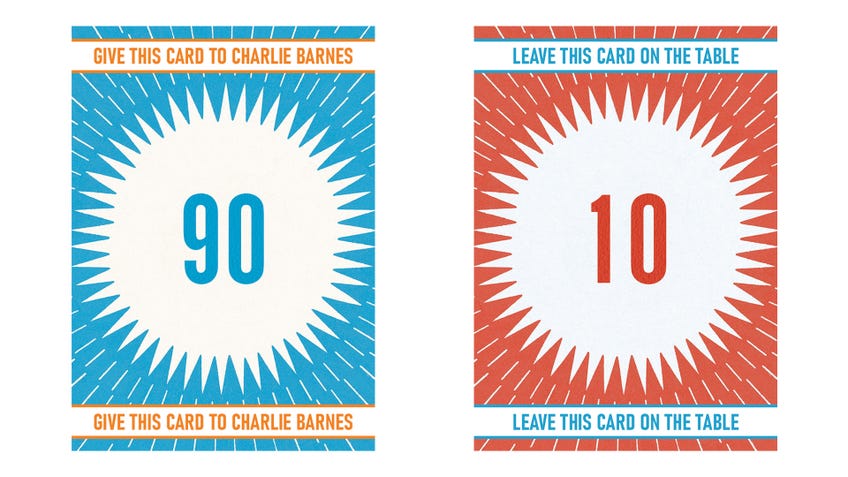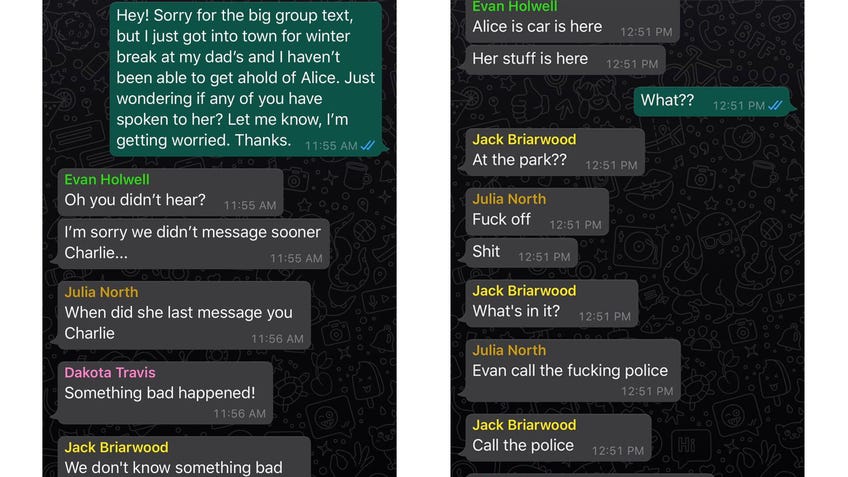I solved a small-town mystery over WhatsApp in the tense, thrilling teen drama RPG Alice is Missing - Kickstarter preview
Enjoy the silence.
About a month ago, I was approached to take part in a session of RPG designer Spenser Starke’s latest project, Alice is Missing. The players were told we’d be playing small-town teens wrapped up in a local tragedy, that’d we only be able to speak through text messages and that events would play out in real time as a clock ticked down to the story’s inevitable - and emotional - finale. Naturally I typed “Yes” so hard I almost broke my phone screen.
If you’ve been keeping an eye on the Dicebreaker YouTube channel, you’ll know that I have high opinions of Starke’s previous RPG, Icarus - my favourite tabletop game of last year. You can understand my excitement as I started to see parallels between the two games as Spenser took me through a pre-release version of Alice is Missing during a Discord call. The tight ‘draw a card, answer a question’ framework of Icarus’ world-building (and subsequent unbuilding, as per the RPG’s depiction of a civilisation’s collapse) is still the foundation for most of the things that happen in Alice, but there’s an added layer of control over the information handed to each player as they secretly expand the story and divulge information at their own pace.
Alice is Missing asks its players to step away from the action-driven power fantasy of many modern RPGs and instead take the roles of helpless teenagers stuck in bedrooms in their parents’ house, desperately searching for the truth via hearsay and rumours amongst their group of close friends. Set in the fictional northern California town of Silent Falls, the group of teens must deal with the fallout after one of their best friends - the titular Alice - disappears amongst a web of suspicious characters and conspiracy theories. As an old acquaintance returns to the town amidst the search, it’s on the players’ characters to bring them up to speed, sharing and dissecting information as a group to reach the heart of the mystery.
Unlike other tabletop RPGs, the heart of the game doesn’t take place hunched around a table rolling dice and vocalising your characters’ flaws in person, but is instead confined to a group chat on your phones.
The upcoming RPG is driven by three interlocked elements that work together to create its setting, story and characters: the drawing of cards, a digital timer and a real-life group chat where the players send each other messages in-character. The world is sketched out by a series of decks of cards containing details such as suspects, prompts and characters, before the players colour it in through their roleplaying. (Starke demonstrated the card-driven aspects using digital tabletop app Roll20.) A 90-minute timer runs throughout the session, with moments in the story unfolding in real time. Most importantly, unlike other tabletop RPGs, the heart of the game doesn’t take place hunched around a table rolling dice and vocalising your characters’ flaws in person - in fact, you can’t speak out loud - but is instead confined to a group chat on your phones in an instant messenger app such as WhatsApp or iMessage.

Before we begin our session, Starke introduces us to the titular character at the centre of the story. There are a few different versions of Alice to pick from, allowing for the potential of different experiences during repeat playthroughs. Each outline of Alice provides basic details about who she is as a person, presented in the style of a missing person poster. Our Alice is a grade-A student. She’s pegged for an Ivy League school and spends her entire life focusing on her classes and extracurriculars. (Starke hints at an alternative Alice profile that sees her become a ‘punk’ high school dropout, drastically changing how we might have envisioned the characters around her.) We take on the roles of Alice’s friends and classmates; people that know her well enough to be personally invested and desperate for answers when the news of her disappearance spreads through the small town.
Starke has us draw these characters from a pool, choosing the ones we feel the most interested in. I let the other players pick their favourites and take the spare part. Julia North is Alice’s secret girlfriend. I decide no-one in her friend group is aware that Julia is queer, giving her a difficult inner conflict as she wrestles with the need to keep her sexuality private and leading her to withhold important information around Alice’s disappearance. The rest of the group includes Alice’s brother, Jack Briarwood; best friend, Dakota Travis; and her secret admirer, Evan Holwell. By following the question prompts on our character cards we learn secrets that only our character knows, as well as answering questions about Alice. I explain to the group how Alice and I met, before privately constructing a creepy anonymous email that I received about my relationship with her - and that no-one else knows about, unless I choose to bring it up.

Together we begin to construct the rural piece of Americana that we call home, fleshing out its familiar locations and potential conspirators. We all have our suspicions about who might be responsible for Alice’s disappearance. As part of the setup, we each draw a suspect card that prompts us to explain what it is about a certain person that makes them suspicious, as well as a location card that helps us generate the details of the world around us. We jot the information down on our character sheets.
Once the scene is set, we’re each given one more set of cards. These have ominous numbers in large print on their backs, linked to the timer that drives the game. We keep the cards facedown and flip them over to read privately only when the 90-minute timer that runs throughout the playthrough hits that number, triggering an event with another question prompt and escalating the story towards its finale.

Although the players themselves are unable to talk, Starke provides a link to a YouTube video with the timer ticking down, accompanied by a licensed playlist of appropriately melancholy and atmospheric indie guitar rock. The music acts not just as a way of setting the mood and filling the silence, but separates the players into different headspaces by popping on headphones and blocking out the real world. Although we were isolated from each other by playing remotely, I imagine simulating a degree of separation is an important factor for sessions played in the same room.
Although we were isolated from each other by playing remotely, simulating a degree of separation is an important factor for sessions played in the same room.
With our characters created and setup complete, all that’s left is to dive into an hour-and-a-half of tense, hormone-charged interactive drama. We change each other’s names to our Silent Falls alter-egos in our phone contacts. Starke adds us to a group WhatsApp chat under the guise of Charlie Barnes, the group’s fifth and final character. Much like Starke’s dice-stacking RPG Icarus, Alice is Missing doesn’t require a GM to facilitate its storytelling, with the timer and cards providing the game structure. The player in the closest role to the would-be GM is just as in the dark when it comes to how the story could play out, with the pool of possible events and outcomes forming the backbone of each session’s plot.

The deck of random event cards is created before the game starts; while you can end up with the same cards in a different session, the way in which they interact with each other and build on previously-established plot points keeps things fresh during repeat plays. The cards’ interpretation by the players is flexible, sticking to a few core guidelines in the rulebook. A prompt might be as simple as “There’s a public statement from the police, what have they found?” or provide more complex instructions. In our case, the end of the game saw a surprise gameplay twist to go along with a surprising story reveal, introducing a brand new side to the narrative.
Our session features news of Alice’s creepy teacher vanishing not long after her own disappearance, the teen’s car turning up abandoned and her obsessive ex-boyfriend banging on my front door looking for answers. These reports are fleshed out by the player who reads the card and delivered to the rest of the group in character. “Guys, are you watching Channel 5?” one player might hurriedly type in the chat, before spilling the latest developments in the case.

Once the final card is drawn at the end of the 90 minutes, Alice’s fate is decided. No more messages can be posted in the chat and the music slowly fades out, allowing the players to decompress. Starke hits play on the last voice messages each of the characters left on Alice’s phone before her disappearance, recorded by the players before the game begins. The reveal - inspired by Stephen Dewey’s wonderful Ten Candles, in which players record an “If you’re hearing this, I’m dead” tape message played at the RPG’s conclusion - sees the mundane scraps of communication between friends become poignant reminders of where it all began, bringing the experience full-circle.
After our session had come to an end, the group and I took some much-needed deep breaths.
After our session had come to an end, the group and I took some much-needed deep breaths. While it will not always be the case, our story did not have a happy ending; Starke is upfront about the possibility for Alice is Missing to bring up some potentially upsetting experiences among players as it explores topics including death, violence and family trauma.
Once the group had had a moment to recover after the tense finale, the atmosphere was electric. Despite the gameplay drawing from Starke’s previous game Icarus, Alice is Missing is unlike any RPG I have ever played. The hidden prompts deliver all the joy of weaving a story together with friends, while keeping the players in the dark about the wider mystery and fuelling their search for new information. The relatively mundane setting of small-town America quickly becomes a thrilling landscape to explore.
Even in silence, it’s amazing how natural it is to enter into the minds of your teenage counterparts, subtly changing the way you type messages in the group chat to reflect their personality and mood. I was surprised how quickly I became Julia North, curled up on my couch with little more than a phone and some headphones, desperately trying to find Alice.
Alice is Missing is currently live on Kickstarter.


